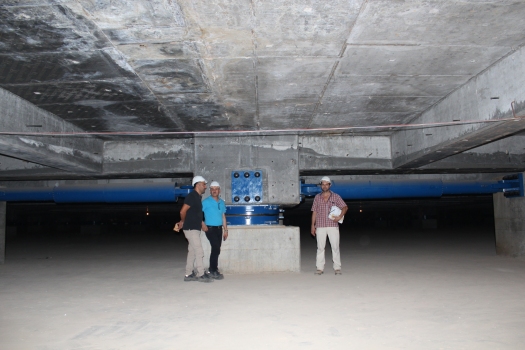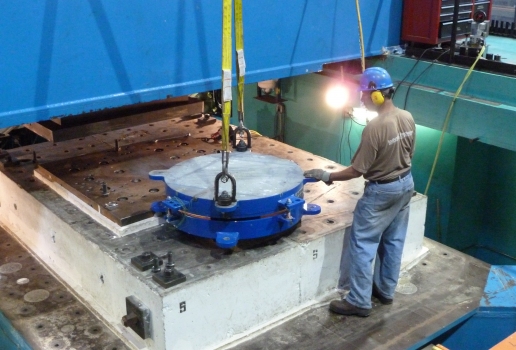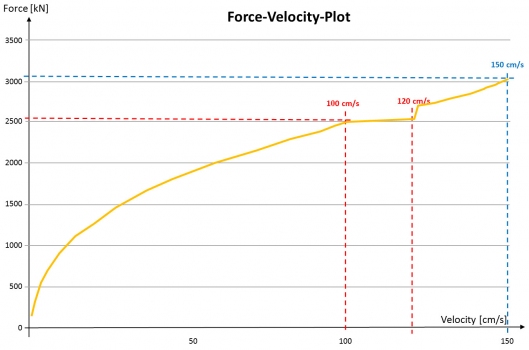500 years earthquake protection for Great Mosque of Algiers
The Great Mosque of Algiers (Djamaâ El Djazïr) will be the third biggest in the world and has to last for at least 500 years – at least theoretically. Consequently it has to be protected against earthquake which has to be expected in this region. The challenge was to devise a protection system that protects both structure and humans at small and medium size earthquakes, and also prevents the structure from a collapse in case of the maximum credible earthquake. MAURER developed a protection system consisting of 246 sliding pendulum bearings and 80 adaptive hydraulic dampers.
The Great Mosque with a total area of 400,000 m² and daily 120,000 visitors shall be completed in 2017. The central structure is the Prayer Hall with a base area of 145 x 145 m and a height of 65 m. It will host up to 32,000 visitors.
Two load cases assumed
In this region the planners assume two cases of earthquake. For the DBE case (Design Basis Earthquake), a recurrence period of 475 years was assumed, thus a relatively high probability. For this case, humans and structure as well as the contents have to be protected. Whereas "contents" stands for the very precious equipment like pictures, steles, decoration, etc., comparable to a museum. An MCE event (Maximum Considered Earthquake) was assumed in a frequency of 2,475 years. In that case, at least the visitors and the structure have to be protected.
In order to cover both load cases, a hybrid solution consisting of pendulum bearings and dampers was devised.
- 246 pendulum bearings (SIP – Sliding Isolation Pendulum) isolate the structure horizontally from its base.
- 80 horizontally acting hydraulic dampers ensure that the horizontal displacement of the structure is limited to ±655 mm.
The period of the system displacement was fixed to 3.1 seconds, to ensure that the acting maximum horizontal accelerations (PGA = Peak Ground Acceleration) are being sufficiently filtered and reduced.
DBE: Sliding Pendulum Bearings (SIP)
The sliding pendulum bearings of type SIP are mainly catering for the design earthquake. They can be likened to an all-directional movable spherical bearing, whereby both sliding surfaces as well as the calotte are concave shaped. In case of earthquake, SIP bearings have to cater to four functions:
- They carry the vertical load of the structure. Per each bearing this makes up to 2,730 tons. The special of the SIP bearing is its stability against this very high load even under maximum displacement, thus absolutely safe.
- The sliding surfaces facilitate horizontal sliding displacements of up to ±655 mm, and convert the kinetic energy via 3 % friction into heat.
- The bearings isolate the Mosque from its base such that it "calmly" rests (while its base displaces). Thus the filigree structure as well as its contents will not suffer damages.
- After a seismic event the bearing recenters automatically into its original position, caused by the concavely shaped sliding surfaces. This is important to prevent a moving away of the structure from its base, when the seismic hits should occur several times into the same direction.
Each of the 246 SIP bearings has a base area of up to 1360 x 1360 mm. They are placed underneath the columns that carry the mosque, and protect humans, the structure itself as well as its contents.
The relatively minor friction coefficient of the bearing of only 3 % is sufficient that in case of the design earthquake the horizontal accelerations of the structure can be limited to 0.12 g. This is an effective protection of the precious contents of the structure.
For the MCE, a friction coefficient of approx. 10-12 % would be required to limit the displacement to ±655 mm. But with such a high friction coefficient the bearings would not move when the weaker design earthquake would occur. As a consequence, the structure, caused by the high horizontal accelerations, would swing up, and the precious contents would be considerably damaged.
MCE: Activation of additional adaptive hydraulic dampers
The limitation of the horizontal displacement is the most important task in case of the MCE. Therefore 40 hydraulic dampers were installed both into longitudinal and lateral direction. Their maximum response force is 3,065 kN.
Their special feature is that they not only cover the maximum earthquake with a PGA of 0.65 g, but react adaptively, depending on the displacement velocity of the piston. In case of the design earthquake they only bring about a very little response force, but in case of a strong earthquake they react aggressively with a high response force, thereby converting the kinetic energy into heat (dissipation). Thus, in case of smaller or medium earthquakes the dampers are almost not active; this allows the SIP bearings to act very smoothly and soft.
In case of a maximum earthquake in Algiers a horizontal acceleration of 0.4 g has to be assumed. Caused by the strict request of a lifetime of 500 years, the importance of the structure and by safety concerns of the authorities, both bearings and dampers were designed for a horizontal acceleration of 0.65 g.
Constant response force in the ultimate areas
Moreover, the specification of KREBS+KIEFER Ingenieure GmbH was a safety factor of 1.2. Consequently, the rising response force had to be kept constant at an assumed velocity of 100 to 120 cm/s. Thus, a valve system was employed.
Parallel to this, according to EN15129 a safety factor of 1.5 had to be observed, such that the performance of the dampers had to be proven for a displacement velocity of up to 150 cm/s. In reality this load case will probably not occur, but bearings, dampers and their anchor systems had to be designed accordingly.
Tests at Universities of San Diego and Pavia
For the CE certification, tests according to EN15129 were requested. Both dampers and bearings were tested at the University of California in San Diego, because only there the prototypes could be tested with full load, displacement velocity and amplitude. Even after 10 simulations with the maximum earthquake, the bearings were fully functional. These tested prototypes were then installed into the structure, after the viscous fluid as well as the sealing had been replaced.
In the EU Center Pavia additional production tests were carried out with reduced test program. These structural components then were directly sent for installation.
Additional inner calotte
The pendulum bearings display of a further specialty, which is owed to the long lifetime of 500 years. In the inner of the bearing there is a calotte with a spherical hinge that can accommodate 1 % of rotation into all directions. Thus, changes or modifications like a settlement of the ground or mistakes at installation can be balanced. Without such a hinge the bearings would be subject to a continuous skew position, which in extreme case could lead to a damage of the sliding material.
Replaceable bearings with only 2 mm jacking up
However, if anyway some time in future a damage at the bearings should occur, like for example caused by a fire, the bearings can be replaced. Anchor plates with many concrete anchors were installed, to which the bearings were fixed by way of screws. This is quite elaborate, but it allows for a bearing displacement by way of jacking up the adjacent structure by only 2 mm. A higher jack-up value would not be possible, for statical reasons.
Economics
At the hand of the many elaborate details the question arises for the costs of the hybrid solution SIP bearings plus hydraulic dampers, because the original design called for cheaper elastomeric bearings of 1,600 mm diameter and 1,000 mm height. "Apart from the fact that these bearings would have tilted at the hand of the maximum displacement, in regard to the total system they would have been the more uneconomical solution", explains Peter Huber, project manager of MAURER. "Moreover, the technically safer and more reliable hybrid solution stands for the more economic system, when taking the total costs of the structure into account. Lots of savings can be realized in the structure itself, because the acting forces can be reduced more efficiently, thus the structure could be built considerably more slender."
References
Structure Types
- About this
data sheet - Product-ID
7515 - Published on:
19/05/2017 - Last updated on:
19/05/2017




 MAURER SE
MAURER SE 
